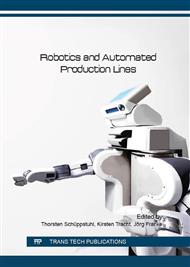[1]
Information of the German Ministry of Economics and Energy (BMWi), found on: https: /www. destatis. de/DE/Publikationen/Thematisch/Preise/Energiepreise/EnergiepreisentwicklungPDF_5619001. pdf?_blob=publicationFile (checked Jan 4th, 2015).
Google Scholar
[2]
R. Schmitt, E. Permin, Characterization of Future Key Performance Indicators and Constraints for Self-Optimizing Assembly Systems, In: R. Schmitt, Proceedings of the 11th International Symposium on Measurement Technology and Intelligent Instruments ISMTII 2013, 1st July - 5th July, 2013 Aachen, Germany.
Google Scholar
[3]
Information provided by ABB (technical specification sheets), as e. g. on: http: /new. abb. com/products/robotics/industrial-robots/irb-140/irb-140-data (checked Jan 4th, 2015).
Google Scholar
[4]
A. Shaik, T. Nkgathoe, G. Bright, A 6 DOF Robot Design and Simulated Energy Usage Comparison, In: IEEE (Eds. ), 6th Robotics and Mechatronics Conference (RobMech), 1st ed., 2013, p.34–39.
DOI: 10.1109/robomech.2013.6685488
Google Scholar
[5]
P. Ystgaard, T. B. Gjerstad, T. K. Lien, A. P. Nyen, Mapping Energy Consumption for Industrial Robots, in: D. A. Dornfeld and B. S. Linke (Eds. ), Leveraging Technology for a Sustainable World, 1st ed., Heidelberg: Springer, 2013, p.251–256.
DOI: 10.1007/978-3-642-29069-5_43
Google Scholar
[6]
P. Klüger, Roboter, die nichts zu tun haben, schicken wir schlafen, Industrieanzeiger 42 (2009), pp.32-33.
Google Scholar
[7]
Z. Liu, W. Bu, J. Tan, Motion navigation for arc welding robots based on feature mapping in a simulation environment, Robotics and Computer-Integrated Manufacturing 26 (2010), pp.137-144.
DOI: 10.1016/j.rcim.2009.09.002
Google Scholar
[8]
D. Meike, A. Senfelds, L. Ribickis, Power converter for DC bus sharing to increase the energy efficiency in drive systems, in: Industrial Electronics Society, IECON 2013 - 39th Annual Conference of the IEEE, vol., no., pp.7199-7204.
DOI: 10.1109/iecon.2013.6700329
Google Scholar
[9]
Paryanto, M. Brossog, M. Bornschlegl, J. Franke, Reducing the energy consumption of industrial robots in manufacturing systems, In: International Journal of Advanced Manufacturing Technology, May 2015, Volume 78, Issue 5, pp.1315-1328.
DOI: 10.1007/s00170-014-6737-z
Google Scholar
[10]
T. Trung, J. Kotlarski, B. Heimann, T. Ortmaier, Dynamics identification of kinematically redundant parallel robots using the direct search method, Mechanism and Machine Theory 52 (2012), p.277–95.
DOI: 10.1016/j.mechmachtheory.2012.02.002
Google Scholar
[11]
L. Yan, G. M. Bone, Are parallel manipulators more energy efficient?, in: H. Zhan (ed. ), Integrating Intelligent Machines with Humans for a Better Tomorrow, 1st ed., Piscataway, New Jersey, USA, 2001, p.41–46.
Google Scholar
[12]
B. Corves et al., A New Way of Grasping: PARAGRIP - The Fusion of Gripper and Robot, in: Grasping in Robotics. ISBN: 978-1-4471-4663-6, Springer, London, 2013, Chapter 17.
DOI: 10.1007/978-1-4471-4664-3_17
Google Scholar
[13]
C. Brecher et al., Integrative production technology for high-wage countries, Springer Berlin Heidelberg, (2012).
Google Scholar
[14]
R. Schmitt et al., Metrology assisted assembly of airplane structure elements, in: Procedia CIRP, DOI 10. 1016/j. procir. 2014. 10. 073, 2014, pp. S. 116-121.
DOI: 10.1016/j.procir.2014.10.073
Google Scholar
[15]
J. Kurilova-Palisaitiene. et al., Industrial energy efficiency potentials, An assessment of three different robot concepts, submitted to International Journal of Sustainable Engineering (2016).
DOI: 10.1080/19397038.2017.1284280
Google Scholar
[16]
T. Javied, T. Rackow, R. Stankalla, C. Sterk, J. Franke, A Study on electrical Energy Consumption of Manufacturing Companies in the German Industry with the Focus on Electric Drives, in: Proceedings of the 48th CIRP Conference on Manufacturing Systems, Ischia, (2015).
DOI: 10.1016/j.procir.2015.10.006
Google Scholar
[17]
E. Müller, T. Löffler, Improving Energy Efficiency in Manufacturing Plants – Case Studies and Guidelines, in: W. ElMaraghy (ed. ), Life Cycle Engineering in the Sustainability Age, 1st ed., Windsor, Ontario, 2009, p.465–471.
Google Scholar
[18]
Information provided by German Association of Energy and Water Industries BDEW, found on: https: /www. bdew. de/internet. nsf/id/energiemix-de (checked Jan 4th, 2015).
Google Scholar
[19]
Information provided by the International Federation of Robotics, found on: www. ifr. org/industrial-robots/statistics/ (checked Jan 4th, 2015).
Google Scholar


